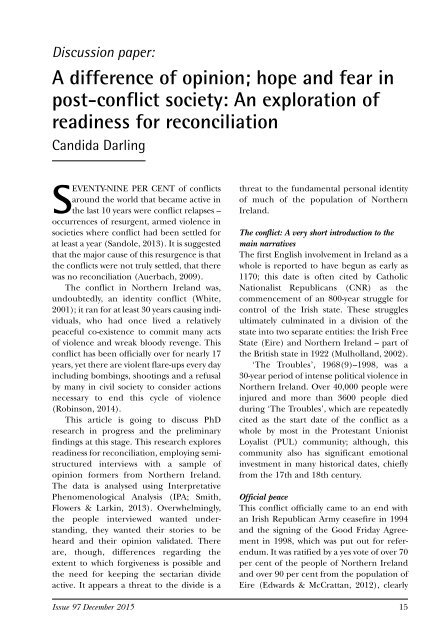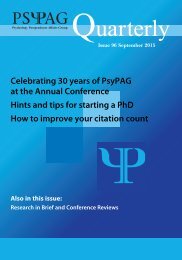Social Psychology Special Issue
XFCu7
XFCu7
You also want an ePaper? Increase the reach of your titles
YUMPU automatically turns print PDFs into web optimized ePapers that Google loves.
Discussion paper:<br />
A difference of opinion; hope and fear in<br />
post-conflict society: An exploration of<br />
readiness for reconciliation<br />
Candida Darling<br />
SEVENTY-NINE PER CENT of conflicts<br />
around the world that became active in<br />
the last 10 years were conflict relapses –<br />
occurrences of resurgent, armed violence in<br />
societies where conflict had been settled for<br />
at least a year (Sandole, 2013). It is suggested<br />
that the major cause of this resurgence is that<br />
the conflicts were not truly settled, that there<br />
was no reconciliation (Auerbach, 2009).<br />
The conflict in Northern Ireland was,<br />
undoubtedly, an identity conflict (White,<br />
2001); it ran for at least 30 years causing individuals,<br />
who had once lived a relatively<br />
peaceful co-existence to commit many acts<br />
of violence and wreak bloody revenge. This<br />
conflict has been officially over for nearly 17<br />
years, yet there are violent flare-ups every day<br />
including bombings, shootings and a refusal<br />
by many in civil society to consider actions<br />
necessary to end this cycle of violence<br />
(Robinson, 2014).<br />
This article is going to discuss PhD<br />
research in progress and the preliminary<br />
findings at this stage. This research explores<br />
readiness for reconciliation, employing semistructured<br />
interviews with a sample of<br />
opinion formers from Northern Ireland.<br />
The data is analysed using Interpretative<br />
Phenomenological Analysis (IPA; Smith,<br />
Flowers & Larkin, 2013). Overwhelmingly,<br />
the people interviewed wanted understanding,<br />
they wanted their stories to be<br />
heard and their opinion validated. There<br />
are, though, differences regarding the<br />
extent to which forgiveness is possible and<br />
the need for keeping the sectarian divide<br />
active. It appears a threat to the divide is a<br />
threat to the fundamental personal identity<br />
of much of the population of Northern<br />
Ireland.<br />
The conflict: A very short introduction to the<br />
main narratives<br />
The first English involvement in Ireland as a<br />
whole is reported to have begun as early as<br />
1170; this date is often cited by Catholic<br />
Nationalist Republicans (CNR) as the<br />
commencement of an 800-year struggle for<br />
control of the Irish state. These struggles<br />
ultimately culminated in a division of the<br />
state into two separate entities: the Irish Free<br />
State (Eire) and Northern Ireland – part of<br />
the British state in 1922 (Mulholland, 2002).<br />
‘The Troubles’, 1968(9)–1998, was a<br />
30-year period of intense political violence in<br />
Northern Ireland. Over 40,000 people were<br />
injured and more than 3600 people died<br />
during ‘The Troubles’, which are repeatedly<br />
cited as the start date of the conflict as a<br />
whole by most in the Protestant Unionist<br />
Loyalist (PUL) community; although, this<br />
community also has significant emotional<br />
investment in many historical dates, chiefly<br />
from the 17th and 18th century.<br />
Official peace<br />
This conflict officially came to an end with<br />
an Irish Republican Army ceasefire in 1994<br />
and the signing of the Good Friday Agreement<br />
in 1998, which was put out for referendum.<br />
It was ratified by a yes vote of over 70<br />
per cent of the people of Northern Ireland<br />
and over 90 per cent from the population of<br />
Eire (Edwards & McCrattan, 2012), clearly<br />
<strong>Issue</strong> 97 December 2015 15



